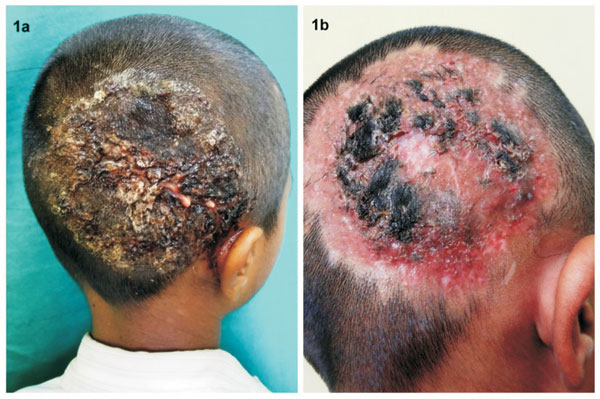A 5-year-old otherwise healthy boy presented to us
with lesions over scalp, for 1 month. He had been treated with various
systemic antibiotics and topical corticosteroids without any response.
Cutaneous examination revealed a large mildly tender erythematous boggy
swelling, associated with overlying crust (Fig. 1) and
loss of hair over occipital area, extending towards the temporal region
and post-auricular area of right side. There was sero-purulent discharge
from few lesions. Nails and mucosae were normal. A KOH preparation made
from the lesion showed fungal hyphae and the culture for bacterial
growth showed growth of Staphylococcus. A diagnosis of Kerion was
made and the patient was given prednisolon 1mg/kg/d for 2 weeks and
griseofulvin 375 mg daily at bedtime for 6 week; the lesions showed
marked improvement with re-growth of hairs in a few areas (Fig.
1b).
 |
|
Fig. 1 Large erythematous boggy
swelling associated with overlying crust (1a) and the healed
lesion after treatment (1b).
|
A Kerion is an inflammatory variant of tinea capitis
as a result of overzealous host response leading to boggy, purulent
plaques with abscess formation and alopecia. It is most commonly caused
by Trichophyton mentagrophytes and Trichophyton verrucosum.
Clinical differentials include pyodermas (lesions are painful, absent
hyphae), folliculitis decalvans (pustular folliculitis leading to
scarring alopecia; fungal hyphae negative), langerhans cell
histiocytosis (involvement of other organs system with a grave course)
and dissecting cellulites of scalp (begins with deep inflammatory
nodules, primarily over the occiput, that progress to coalescing regions
of boggy scalp; fungal hyphae negative).

